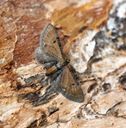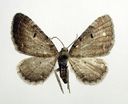Hodges#7586.1
Eupithecia absinthiata
Classification
- Phylum: Arthropoda
- Subphylum: Hexapoda
- Class: Insecta
- Order: Lepidoptera
- Superfamily: Geometroidea
- Family: Geometridae
- Subfamily: Larentiinae
- Tribe: Eupitheciini
- Genus: Eupithecia
- Species: absinthiata
Pronunciation
How to pronounce Eupithecia absinthiata: /juː.pɪˈθiː.siə æbˈsɪnθiːˌeɪtə/
These audio files are automatically generated. While they are not always 100% accurate, they are a good starting point.
Images






Summary
The wormwood pug (Eupithecia absinthiata) is a common moth of the Geometridae family, known for its distinctive warm brown forewings and larvae that feed on various plants, including mugwort. It flies at night during the summer months and has a wide distribution across North America and Europe.
Physical Characteristics
Wingspan 21–23 mm; forewings warm brown with two black spots along the costa and a black discal spot forming a triangle; pale narrow line near the fringe; distinct whitish spot near the tornus; hindwings greyish brown.
Identification Tips
Examination of genital preparation is required for certain identification.
Habitat
Found in various habitats across North America and Europe.
Distribution
Throughout much of North America except the central plains; also found in much of Europe, particularly in the Palearctic region.
Diet
Larvae primarily feed on the flowers of mugwort and a range of other plants including Achillea, Aconitum, Artemisia, Aster, Calluna, Cirsium, Erica, Eupatorium, Pimpinella, Senecio, Solidago, Tanacetum, and Tripleurospermum.
Life Cycle
The species overwinters as a pupa.
Reproduction
Adult moths are nocturnal and are attracted to light; they mate to produce larvae that feed on host plants.
Collecting Methods
- Light trapping at night.
Preservation Methods
- Pinning specimens
- Drying for collection.
Similar Taxa
Tags
- Moth
- Geometridae
- Eupithecia
- Lepidoptera
- Insect